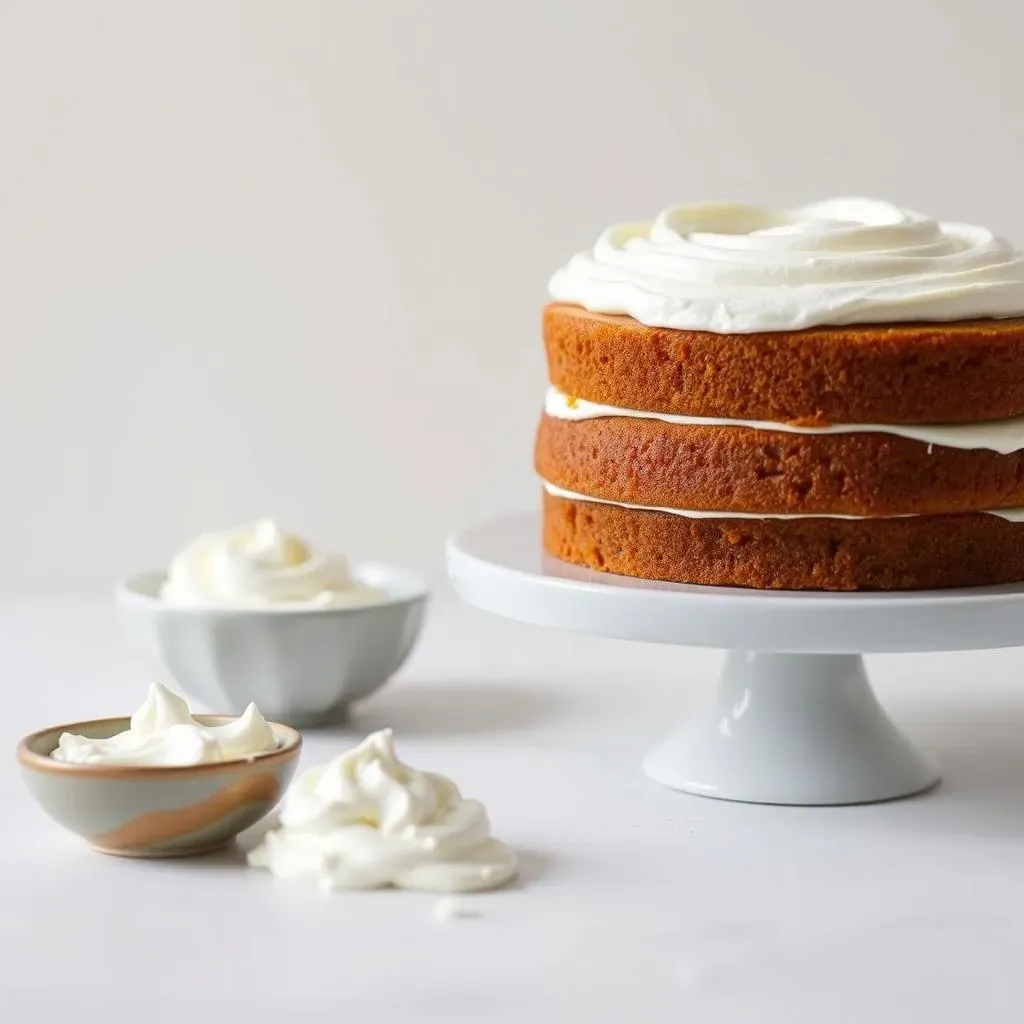Table of Contents
Ever stared blankly at a baking recipe, only to discover you're missing a key ingredient—sour cream? Don't despair! This article tackles the burning question: can you substitute Greek yogurt for sour cream in baking? We'll explore the similarities and differences between these two dairy delights, examining their impact on texture and taste in your favorite baked goods. We'll delve into the science behind successful substitutions, offering practical tips and tricks to ensure your cakes, muffins, and cookies turn out flawlessly. Whether you're a seasoned baker looking for a healthier alternative or a novice trying to make do with what's in your fridge, this guide provides everything you need to confidently swap Greek yogurt for sour cream. Prepare to unlock a world of baking possibilities, as we uncover the secrets to achieving delicious results every time. Get ready to discover if that seemingly simple swap of "can you substitute Greek yogurt for sour cream in baking" truly holds up to scrutiny!
Can You Substitute Greek Yogurt for Sour Cream in Baking?
Can You Substitute Greek Yogurt for Sour Cream in Baking?
The Great Yogurt-Sour Cream Debate
So, you're wondering if you can swap Greek yogurt for sour cream in your baking? It's a question that's plagued bakers for ages (okay, maybe not ages, but definitely long enough to warrant a detailed exploration!). The short answer is: yes, often! But it's not quite as simple as a one-to-one swap. Both Greek yogurt and sour cream offer a tangy flavor and creamy texture, which are key in many baked goods. However, their fat content and consistency differ slightly, leading to potential variations in your final product.
Think of it like this: sour cream is the seasoned veteran, reliable and predictable. Greek yogurt is the enthusiastic newcomer, full of potential but needing a little guidance. Understanding these nuances is vital for baking success. The key is to choose the right type of Greek yogurt, and sometimes make minor adjustments to your recipe to compensate for the differences.
Ingredient | Fat Content (approx.) | Typical Consistency |
|---|---|---|
Sour Cream | 18-20% | Thick and creamy |
Full-Fat Greek Yogurt | 10-15% | Thick, but slightly less creamy |
Low-Fat Greek Yogurt | <5% | Thinner, less creamy |
Factors Affecting Your Baking Success
The success of your substitution hinges on a few key factors. First, the type of Greek yogurt matters. Full-fat Greek yogurt is your best bet, mimicking sour cream's richness and creaminess most closely. Low-fat or non-fat varieties will result in a drier, less rich final product. Secondly, consider the recipe itself. Some recipes are more forgiving than others. For example, a dense cake might tolerate a substitution better than a delicate sponge cake.
Finally, don't be afraid to experiment! Start with small adjustments. If your recipe calls for 1 cup of sour cream, try substituting ¾ cup of full-fat Greek yogurt initially. You might need to add a tablespoon or two of oil or melted butter to compensate for the lower fat content of the yogurt. Baking is a science, but it's also an art—a delicious, sometimes messy art!
- Use full-fat Greek yogurt for best results.
- Start with a slightly smaller amount of yogurt than the sour cream called for.
- Add extra oil or butter if needed to compensate for reduced fat.
- Don't be afraid to experiment!
Greek Yogurt vs. Sour Cream: A Baking Showdown
Greek Yogurt vs. Sour Cream: A Baking Showdown
Greek Yogurt vs. Sour Cream: A Baking Showdown
Okay, let's get down to brass tacks: Greek yogurt versus sour cream in baking. It's a battle of the tangy, creamy contenders! While both bring acidity and richness to baked goods, they're not identical twins. Sour cream, with its higher fat content (around 18-20%), delivers a richer, more luxurious texture. Think of that decadent, melt-in-your-mouth brownie – that's sour cream’s superpower. Greek yogurt, on the other hand, typically boasts a lower fat content (depending on the type, ranging from under 5% to around 15%), resulting in a slightly lighter, sometimes tangier final product. It’s the healthier, more athletic sibling, great for those watching their waistlines (and their cholesterol!). The difference lies in the fat content, which directly impacts moisture and richness.
This isn't to say Greek yogurt is a baking lightweight! It's a fantastic source of protein and adds a delightful tang. The trick is knowing how to harness its unique properties. In many recipes, particularly those with added fats like butter or oil, the difference between Greek yogurt and sour cream is barely noticeable. However, in recipes that rely heavily on the sour cream's richness for moisture and texture, you might need to make some adjustments.
Characteristic | Sour Cream | Full-Fat Greek Yogurt |
|---|---|---|
Fat Content | Higher (18-20%) | Lower (10-15%) |
Texture | Thick and creamy | Thick, but slightly less creamy |
Tanginess | Mildly tangy | Can be more tangy |
Moisture | Adds significant moisture | Adds less moisture |
Let's consider a classic example: muffins. A recipe calling for sour cream will likely yield a tender, moist muffin. Substituting Greek yogurt might result in a slightly drier muffin, unless you compensate by adding a bit more liquid (milk or oil) to the batter. This is where the art of baking comes in! The beauty of baking lies in understanding these nuances and adjusting accordingly. It's about experimentation and fine-tuning the recipe to achieve your desired outcome.
Remember, baking isn't an exact science. Don't be afraid to deviate from the recipe slightly. Taste as you go and adjust the ingredients as needed. A pinch of salt here, a splash of milk there – these small adjustments can make all the difference in achieving that perfect balance of flavor and texture. Even professional bakers often tweak recipes based on their own preferences and the ingredients available to them. So embrace the experimentation and enjoy the process!
- Don't be afraid to experiment!
- Taste as you go and adjust ingredients.
- Small adjustments can make a big difference.
Tips and Tricks for Successful Greek Yogurt Substitutions in Baking
Tips and Tricks for Successful Greek Yogurt Substitutions in Baking
Choosing the Right Greek Yogurt
The first step to successful Greek yogurt substitutions is selecting the right type of yogurt. Full-fat Greek yogurt is your best friend here. Its higher fat content closely mirrors the richness of sour cream, leading to more moist and tender baked goods. Low-fat or non-fat options will lack the necessary richness, potentially resulting in dry or crumbly textures. Think of it like this: full-fat Greek yogurt is the velvet to sour cream's satin; both luxurious, but with slightly different textures.
If you're aiming for a healthier option, full-fat Greek yogurt still offers a significantly lower fat content compared to sour cream, making it a worthwhile compromise. However, if you're working with a recipe that relies heavily on the fat in sour cream for moisture, you might want to stick with the original ingredient or explore other alternatives. Read the recipe carefully; some recipes are more forgiving than others.
Yogurt Type | Fat Content (approx.) | Baking Suitability |
|---|---|---|
Full-Fat Greek Yogurt | 10-15% | Excellent substitute |
Low-Fat Greek Yogurt | <5% | May result in drier baked goods |
Non-Fat Greek Yogurt | <1% | Not recommended for most recipes |
Adjusting Your Recipe for Optimal Results
Once you've chosen your yogurt, it's time to tweak the recipe slightly. Since Greek yogurt has a lower fat content than sour cream, you might need to make adjustments to maintain moisture and texture. A good starting point is to reduce the amount of yogurt used by ¼ cup for every cup of sour cream the recipe calls for. This helps prevent overly moist baked goods. Then, you can add a tablespoon or two of melted unsalted butter, oil, or applesauce to compensate for the decreased fat content.
Remember, every recipe is different. Some recipes are more forgiving than others when it comes to ingredient substitutions. If you're unsure, it's always best to start with a smaller substitution and adjust as needed. Don't be afraid to experiment! Baking is a journey of discovery, and sometimes, the unexpected results are the most delicious ones. Plus, if it doesn't work, you have an excuse to bake again!
- Reduce yogurt amount slightly (e.g., ¾ cup yogurt for 1 cup sour cream).
- Add 1-2 tablespoons of oil, melted butter, or applesauce.
- Start with a small substitution and adjust as needed.
Troubleshooting Common Issues
Even with careful planning, you might encounter a few hiccups when substituting Greek yogurt for sour cream. One common issue is a slightly drier or more crumbly texture. If this happens, don't panic! You can often remedy this by adding a little extra liquid to the batter. Milk, buttermilk, or even a little extra water can help reintroduce moisture. Another potential problem is a slightly tangier flavor. If the tang is overpowering, you can try adding a pinch of sugar or a teaspoon of vanilla extract to balance the flavors.
Ultimately, success in baking with Greek yogurt substitutions comes down to understanding the properties of both ingredients and making informed adjustments. Don't be afraid to experiment and trust your instincts. Baking is a creative process, and sometimes the best results come from embracing the unexpected. Keep track of your experiments; you might just discover your new favorite baking hack!